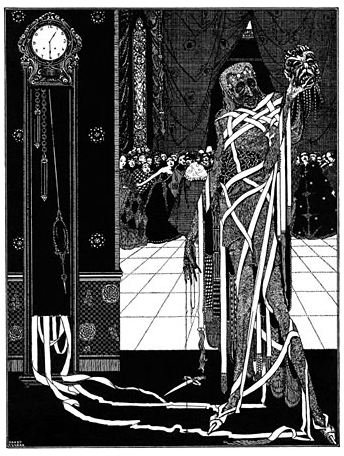A Look at Edgar Allan Poe's Short Stories: "The Masque of the Red Death" Characters and Setting
Setting
Identifying “The Masque of the Red Death” setting is critical to understanding the story.
Setting: The action takes place in the newly constructed “castellated abbey” of Prince Prospero. The castle has been boarded up, leaving “means of neither ingress nor egress” in an effort to keep out the Red Death, a plague that has killed half of the population in Prince Prospero’s kingdom. The majority of the story’s action takes place in the Imperial suite, which contains seven rooms, each exclusively decorated and lighted with a specific color, the exception being the last room whose black interior is complemented by red windows. Although the narrator never gives a specific time, the events occur most likely during the middle ages as indicated by the existence of castles, a sharp division between nobles and peasants, and the existence of a deadly plague.
Analysis: The boarded up castle is the Prince’s attempt to keep out the Red Death. The seven rooms symbolize the seven ages of man, an allusion to a monologue in Shakespeare’s <em>As You Like It</em>. Several plagues decimated the population of Europe during the Middle Ages, the most well known, the Black Death, occurring in the latter half of the 14th-century, killed approximately 40% of Europe’s population.
Characters
Only two characters are named in the story: Prospero and the Red Death.
Prince Prospero: The prosperous Prince invites citizens “from among the knights and dames of his court” to reside with him in his odd fortressed castle. His intent is to prevent the Red Death from affecting him or his guests. He falsely believes that he and his guests can prevent death. The Prince’s name is symbolic. He is wealthy. He is noble. He is respected. He still dies.
**
The Red Death: Prince Prospero throws a costume party at which a figure “tall and gaunt, and shrouded from head to foot in the habilements of the grave” strolls through the castle. “His vesture was dabbed in blood and his broad brow, with all the face, was besprinkled with the scarlet horror.” (149). The Red Death has arrived. Many interpret the story as an allegory of life, the end result being death to all.
Prospero’s Guests: None of Prospero’s guests are named. We do know, however, that they are of noble blood and that peasants and commoners are locked out, leading many to surmise that the story is an allegory for the death of feudalism, an economic system in which peasants worked the land and nobles made the money.
Irony: The Theme of Death
The Prince builds a castle to thwart the Red Death. He surrounds the castle with a “lofty wall” and with “gates of iron.” The guests “brought furnaces and massy hammers and welded the bolts. They resolved to leave no means of ingress nor egress to the sudden despair or of frenzy within.” (145). The fortressed castle fails to keep Death out and ironically keeps the guests imprisoned after the Red Death’s arrival.
The Prince’s purpose is to let his guests forget about death, yet the construction of his Imperial suite, with its “sharp turns” and “novel effects” do little to comfort them. In addition, “the seventh apartment was closely shrouded in black velvet tapestries that hung all over the ceiling and down the wall…The panes here were scarlet–a deep color.” (146). That seems a strange way to help guests forget about death, but not as strange as the ebony clock that rings ominously each hour, causing all to cease their merry revels.
Themes

Death is inescapable - Prince Prospero’s attempt to thwart death proves futile. No matter what the Prince and his guests do, they cannot escape it. They are constantly reminded by the ebony clock and its pendulum’s constant motion.
Control is an illusion - Prince Prospero goes to great lengths to prevent the Red Death from entering his castle. He fails. He falsely believes he can keep death out. Inside the castle, the ebony clock “swung to and fro with a dull, heavy, monotonous clang” that unnerved the guests and forced them to halt in their merry-making. At the cessation of the ringing each guest “looked at each other and smiled as if at their own nervousness and folly and made whispering vows…that the next chiming of the clock should produce in them no similar emotion” (147). The guests are no more successful in their vow to control their thoughts about death than the Prince is in preventing Death’s entrance.
Leaders have a responsibility to protect their subjects - Prospero protects those who least need protection while allowing the commoners and peasants to fend for themselves. This aspect of the story resembles feudalism.
References
This post is part of the series: Masque of the Red Death Study Guide
Avoid becoming a bloody mess on your next short story test. Use this study guide and keep the “Red F” away!
- Summary of “The Masque of the Red Death” by Edgar Allan Poe
- Symbolism in “The Masque of the Red Death”
- “The Masque of the Red Death” Literary Analysis: A Look at Imagery
- Setting, Characters, Theme and Irony in “The Masque of the Red Death”
- An Analysis of Edgar Allan Poe Quotes
